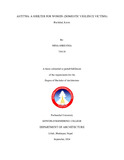Please use this identifier to cite or link to this item:
https://elibrary.khec.edu.np:8080/handle/123456789/842| Title: | Astitwa: A Shelter for Women (Domestic Violence Victims) Pachkhal, Kavre |
| Authors: | Mina Shrestha |
| Advisor: | Ar. Robina Manandhar |
| Issue Date: | 2024 |
| College Name: | Khwopa Engineering College |
| Level: | Bachelor's Degree |
| Degree: | BE Architecture |
| Department Name: | Department of Architecture |
| Abstract: | Any abusive behaviors that occur within a relationship, typically involving one partner exerting power and control over the other can be considered as Domestic violence. The present social imbalance between genders, prevalent since ancient times, continues to cast a shadow over our society in present as well, hindering the progress of women. (United Nations) Hence, �Astitwa: A Shelter for Women (Domestic Violence Victims)� aims to tackle accommodation, physical health and mental well-being challenges faced by victims, while also providing skill enhancement, vocational training, and awareness programs. While working on this idea, definitions of domestic violence from national and international organizations were reviewed, and current laws and policies in Nepal were examined. Data were analyzed, the rehabilitation process and psychological impact on victims were studied, and effective layout designs were researched. National case studies on Women Foundation Nepal, WHR, and Tewa, helped in examining the treatment of domestic violence victims in Nepal, focusing on living spaces, required capacities, design circulation, and privacy. International studies on Women's Opportunity Center in Rwanda and the Shelter for Battered Women in Israel provided insights into the management of open and green spaces, and the maintenance of security and privacy for victims. Unlike the crowded Kathmandu Valley, most places of Kavrepalanchowk are peaceful. Pachkhal, a major city in this district and easily accessible by road is chosen site. Due to its significant number of domestic violence victims�100 reported this fiscal year�makes it a crucial area for focused research and intervention. The design is carried out by concept of three hands holding each other which symbolize support, teamwork, and unity, represented through counseling, empowerment, and dormitory components. Different zoning areas like display area, counseling area, dormitory, training units etc. are placed within the site for comfort of victims. Ultimately, it is hoped that this project will uplift the socio-economic status of victims of domestic violence in Nepal. |
| URI: | https://elibrary.khec.edu.np:8080/handle/123456789/842 |
| Appears in Collections: | Architecture 2075 Batch Thesis |
Files in This Item:
| File | Description | Size | Format | |
|---|---|---|---|---|
| 750119-Mina Shrestha.pdf | 24.84 MB | Adobe PDF |  View/Open |
Items in DSpace are protected by copyright, with all rights reserved, unless otherwise indicated.
